ACCM 4600: AI, Accounting Theory, and Contemporary Issues Report
VerifiedAdded on 2023/06/15
|10
|2226
|102
Report
AI Summary
This report explores the impact of Artificial Intelligence (AI) on the accounting profession, focusing on both the opportunities and threats it presents. It defines AI and discusses how technology has changed accounting practices, highlighting the use of accounting software and the automation of tasks. The report analyzes AI's potential in areas like auditing, risk assessment, analytics, and bank reconciliation, while also addressing concerns about job displacement and the costs associated with AI implementation and maintenance. Ultimately, it recommends that small consulting firms embrace AI to enhance efficiency and strategic decision-making, while also acknowledging the need for human oversight and ethical considerations.
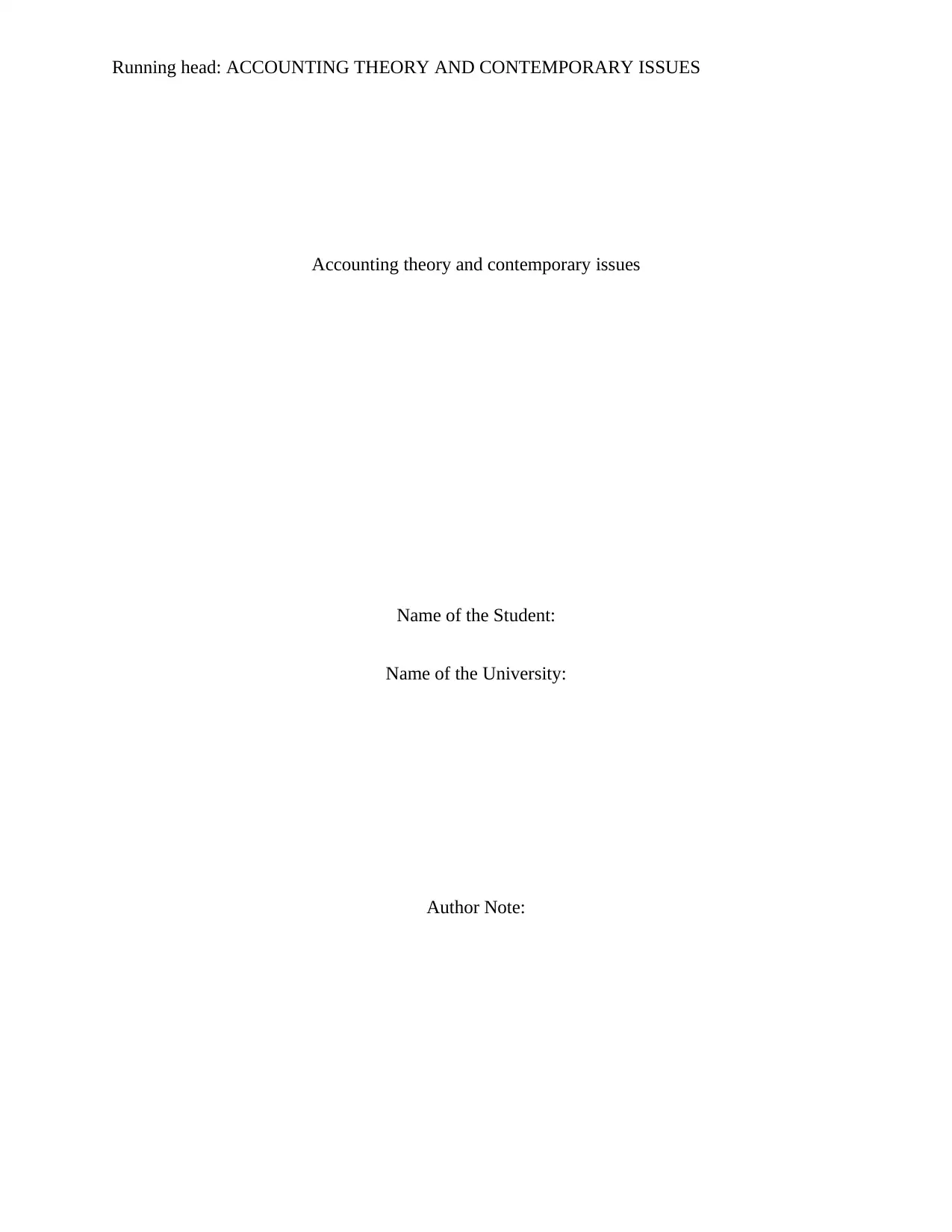
Running head: ACCOUNTING THEORY AND CONTEMPORARY ISSUES
Accounting theory and contemporary issues
Name of the Student:
Name of the University:
Author Note:
Accounting theory and contemporary issues
Name of the Student:
Name of the University:
Author Note:
Paraphrase This Document
Need a fresh take? Get an instant paraphrase of this document with our AI Paraphraser
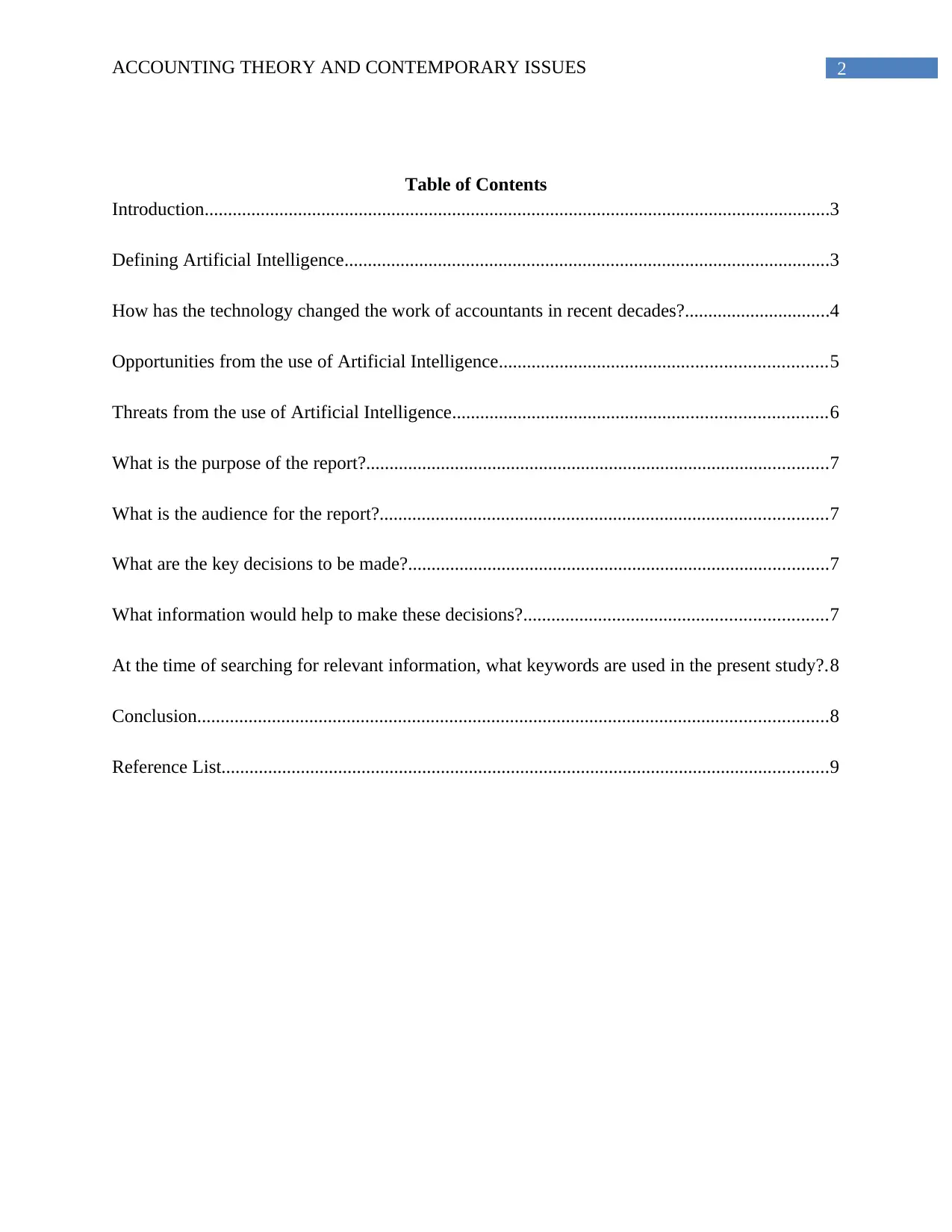
2ACCOUNTING THEORY AND CONTEMPORARY ISSUES
Table of Contents
Introduction......................................................................................................................................3
Defining Artificial Intelligence........................................................................................................3
How has the technology changed the work of accountants in recent decades?...............................4
Opportunities from the use of Artificial Intelligence......................................................................5
Threats from the use of Artificial Intelligence................................................................................6
What is the purpose of the report?...................................................................................................7
What is the audience for the report?................................................................................................7
What are the key decisions to be made?..........................................................................................7
What information would help to make these decisions?.................................................................7
At the time of searching for relevant information, what keywords are used in the present study?.8
Conclusion.......................................................................................................................................8
Reference List..................................................................................................................................9
Table of Contents
Introduction......................................................................................................................................3
Defining Artificial Intelligence........................................................................................................3
How has the technology changed the work of accountants in recent decades?...............................4
Opportunities from the use of Artificial Intelligence......................................................................5
Threats from the use of Artificial Intelligence................................................................................6
What is the purpose of the report?...................................................................................................7
What is the audience for the report?................................................................................................7
What are the key decisions to be made?..........................................................................................7
What information would help to make these decisions?.................................................................7
At the time of searching for relevant information, what keywords are used in the present study?.8
Conclusion.......................................................................................................................................8
Reference List..................................................................................................................................9
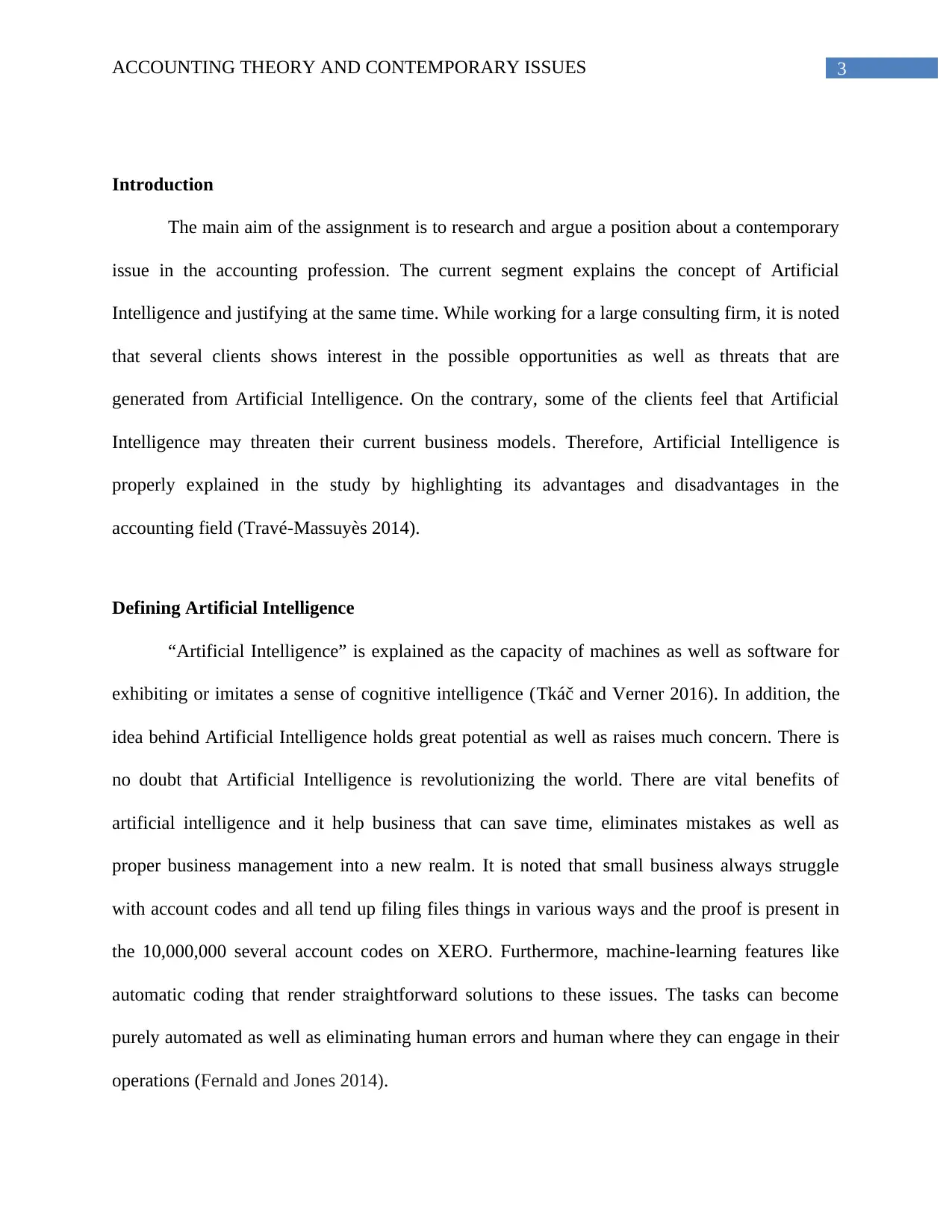
3ACCOUNTING THEORY AND CONTEMPORARY ISSUES
Introduction
The main aim of the assignment is to research and argue a position about a contemporary
issue in the accounting profession. The current segment explains the concept of Artificial
Intelligence and justifying at the same time. While working for a large consulting firm, it is noted
that several clients shows interest in the possible opportunities as well as threats that are
generated from Artificial Intelligence. On the contrary, some of the clients feel that Artificial
Intelligence may threaten their current business models. Therefore, Artificial Intelligence is
properly explained in the study by highlighting its advantages and disadvantages in the
accounting field (Travé-Massuyès 2014).
Defining Artificial Intelligence
“Artificial Intelligence” is explained as the capacity of machines as well as software for
exhibiting or imitates a sense of cognitive intelligence (Tkáč and Verner 2016). In addition, the
idea behind Artificial Intelligence holds great potential as well as raises much concern. There is
no doubt that Artificial Intelligence is revolutionizing the world. There are vital benefits of
artificial intelligence and it help business that can save time, eliminates mistakes as well as
proper business management into a new realm. It is noted that small business always struggle
with account codes and all tend up filing files things in various ways and the proof is present in
the 10,000,000 several account codes on XERO. Furthermore, machine-learning features like
automatic coding that render straightforward solutions to these issues. The tasks can become
purely automated as well as eliminating human errors and human where they can engage in their
operations (Fernald and Jones 2014).
Introduction
The main aim of the assignment is to research and argue a position about a contemporary
issue in the accounting profession. The current segment explains the concept of Artificial
Intelligence and justifying at the same time. While working for a large consulting firm, it is noted
that several clients shows interest in the possible opportunities as well as threats that are
generated from Artificial Intelligence. On the contrary, some of the clients feel that Artificial
Intelligence may threaten their current business models. Therefore, Artificial Intelligence is
properly explained in the study by highlighting its advantages and disadvantages in the
accounting field (Travé-Massuyès 2014).
Defining Artificial Intelligence
“Artificial Intelligence” is explained as the capacity of machines as well as software for
exhibiting or imitates a sense of cognitive intelligence (Tkáč and Verner 2016). In addition, the
idea behind Artificial Intelligence holds great potential as well as raises much concern. There is
no doubt that Artificial Intelligence is revolutionizing the world. There are vital benefits of
artificial intelligence and it help business that can save time, eliminates mistakes as well as
proper business management into a new realm. It is noted that small business always struggle
with account codes and all tend up filing files things in various ways and the proof is present in
the 10,000,000 several account codes on XERO. Furthermore, machine-learning features like
automatic coding that render straightforward solutions to these issues. The tasks can become
purely automated as well as eliminating human errors and human where they can engage in their
operations (Fernald and Jones 2014).
⊘ This is a preview!⊘
Do you want full access?
Subscribe today to unlock all pages.

Trusted by 1+ million students worldwide
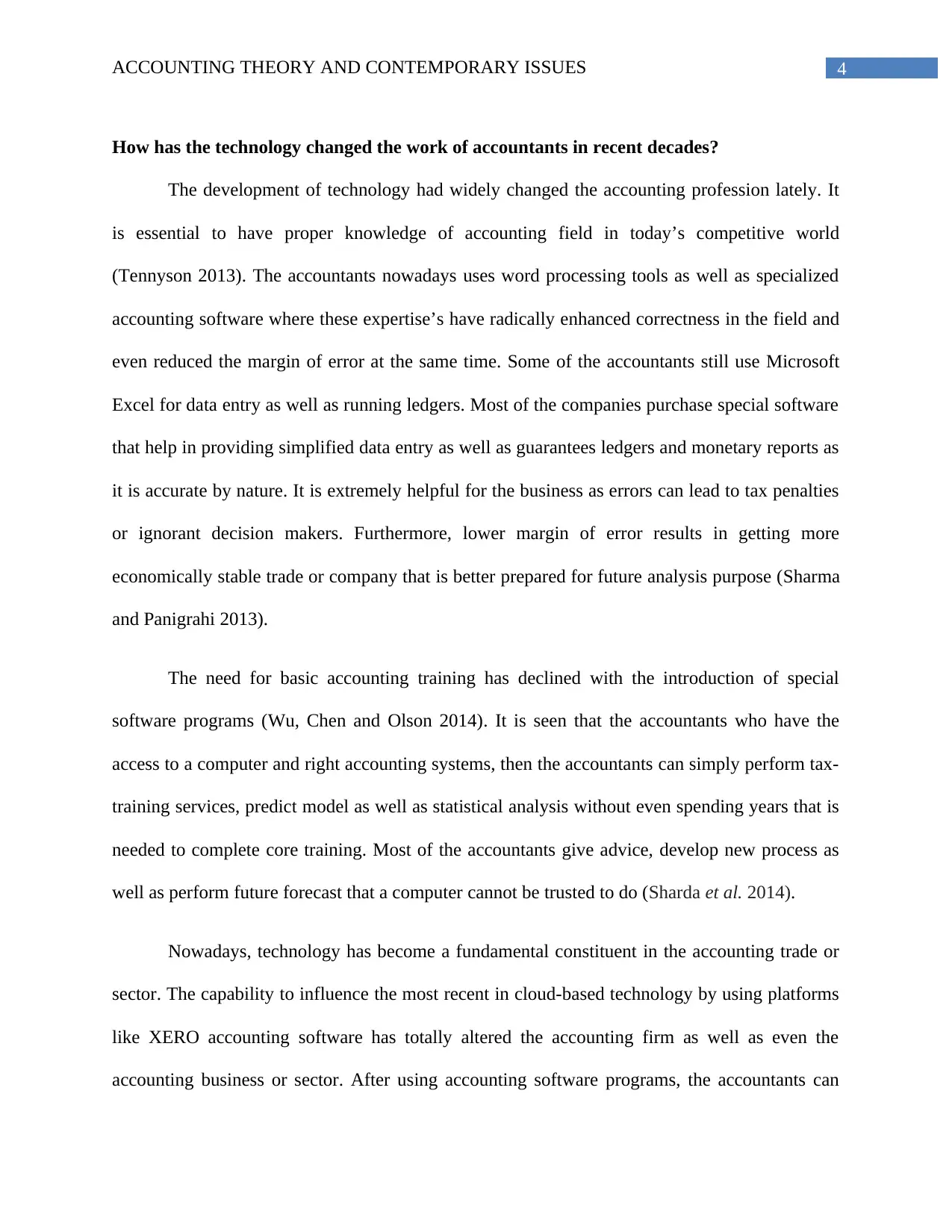
4ACCOUNTING THEORY AND CONTEMPORARY ISSUES
How has the technology changed the work of accountants in recent decades?
The development of technology had widely changed the accounting profession lately. It
is essential to have proper knowledge of accounting field in today’s competitive world
(Tennyson 2013). The accountants nowadays uses word processing tools as well as specialized
accounting software where these expertise’s have radically enhanced correctness in the field and
even reduced the margin of error at the same time. Some of the accountants still use Microsoft
Excel for data entry as well as running ledgers. Most of the companies purchase special software
that help in providing simplified data entry as well as guarantees ledgers and monetary reports as
it is accurate by nature. It is extremely helpful for the business as errors can lead to tax penalties
or ignorant decision makers. Furthermore, lower margin of error results in getting more
economically stable trade or company that is better prepared for future analysis purpose (Sharma
and Panigrahi 2013).
The need for basic accounting training has declined with the introduction of special
software programs (Wu, Chen and Olson 2014). It is seen that the accountants who have the
access to a computer and right accounting systems, then the accountants can simply perform tax-
training services, predict model as well as statistical analysis without even spending years that is
needed to complete core training. Most of the accountants give advice, develop new process as
well as perform future forecast that a computer cannot be trusted to do (Sharda et al. 2014).
Nowadays, technology has become a fundamental constituent in the accounting trade or
sector. The capability to influence the most recent in cloud-based technology by using platforms
like XERO accounting software has totally altered the accounting firm as well as even the
accounting business or sector. After using accounting software programs, the accountants can
How has the technology changed the work of accountants in recent decades?
The development of technology had widely changed the accounting profession lately. It
is essential to have proper knowledge of accounting field in today’s competitive world
(Tennyson 2013). The accountants nowadays uses word processing tools as well as specialized
accounting software where these expertise’s have radically enhanced correctness in the field and
even reduced the margin of error at the same time. Some of the accountants still use Microsoft
Excel for data entry as well as running ledgers. Most of the companies purchase special software
that help in providing simplified data entry as well as guarantees ledgers and monetary reports as
it is accurate by nature. It is extremely helpful for the business as errors can lead to tax penalties
or ignorant decision makers. Furthermore, lower margin of error results in getting more
economically stable trade or company that is better prepared for future analysis purpose (Sharma
and Panigrahi 2013).
The need for basic accounting training has declined with the introduction of special
software programs (Wu, Chen and Olson 2014). It is seen that the accountants who have the
access to a computer and right accounting systems, then the accountants can simply perform tax-
training services, predict model as well as statistical analysis without even spending years that is
needed to complete core training. Most of the accountants give advice, develop new process as
well as perform future forecast that a computer cannot be trusted to do (Sharda et al. 2014).
Nowadays, technology has become a fundamental constituent in the accounting trade or
sector. The capability to influence the most recent in cloud-based technology by using platforms
like XERO accounting software has totally altered the accounting firm as well as even the
accounting business or sector. After using accounting software programs, the accountants can
Paraphrase This Document
Need a fresh take? Get an instant paraphrase of this document with our AI Paraphraser
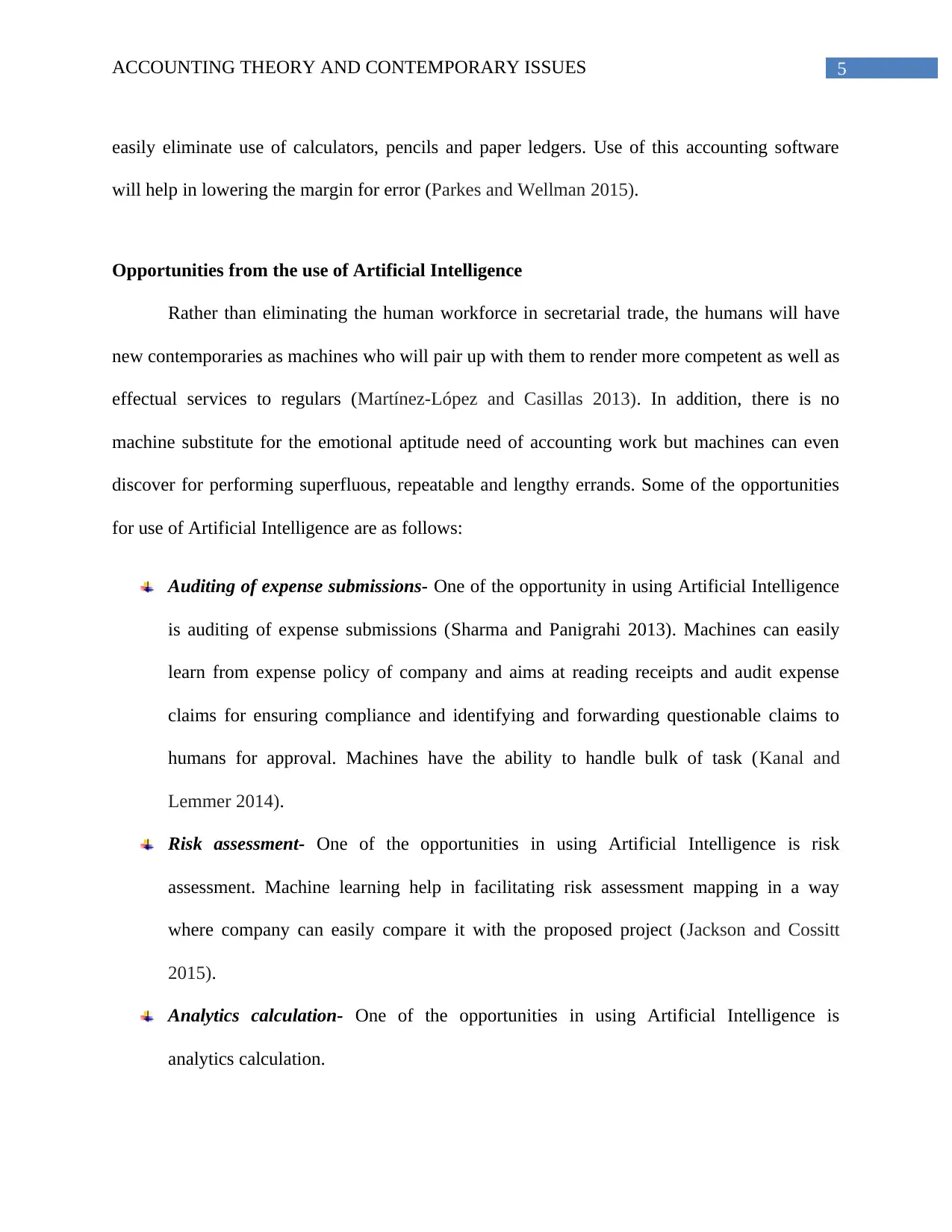
5ACCOUNTING THEORY AND CONTEMPORARY ISSUES
easily eliminate use of calculators, pencils and paper ledgers. Use of this accounting software
will help in lowering the margin for error (Parkes and Wellman 2015).
Opportunities from the use of Artificial Intelligence
Rather than eliminating the human workforce in secretarial trade, the humans will have
new contemporaries as machines who will pair up with them to render more competent as well as
effectual services to regulars (Martínez-López and Casillas 2013). In addition, there is no
machine substitute for the emotional aptitude need of accounting work but machines can even
discover for performing superfluous, repeatable and lengthy errands. Some of the opportunities
for use of Artificial Intelligence are as follows:
Auditing of expense submissions- One of the opportunity in using Artificial Intelligence
is auditing of expense submissions (Sharma and Panigrahi 2013). Machines can easily
learn from expense policy of company and aims at reading receipts and audit expense
claims for ensuring compliance and identifying and forwarding questionable claims to
humans for approval. Machines have the ability to handle bulk of task (Kanal and
Lemmer 2014).
Risk assessment- One of the opportunities in using Artificial Intelligence is risk
assessment. Machine learning help in facilitating risk assessment mapping in a way
where company can easily compare it with the proposed project (Jackson and Cossitt
2015).
Analytics calculation- One of the opportunities in using Artificial Intelligence is
analytics calculation.
easily eliminate use of calculators, pencils and paper ledgers. Use of this accounting software
will help in lowering the margin for error (Parkes and Wellman 2015).
Opportunities from the use of Artificial Intelligence
Rather than eliminating the human workforce in secretarial trade, the humans will have
new contemporaries as machines who will pair up with them to render more competent as well as
effectual services to regulars (Martínez-López and Casillas 2013). In addition, there is no
machine substitute for the emotional aptitude need of accounting work but machines can even
discover for performing superfluous, repeatable and lengthy errands. Some of the opportunities
for use of Artificial Intelligence are as follows:
Auditing of expense submissions- One of the opportunity in using Artificial Intelligence
is auditing of expense submissions (Sharma and Panigrahi 2013). Machines can easily
learn from expense policy of company and aims at reading receipts and audit expense
claims for ensuring compliance and identifying and forwarding questionable claims to
humans for approval. Machines have the ability to handle bulk of task (Kanal and
Lemmer 2014).
Risk assessment- One of the opportunities in using Artificial Intelligence is risk
assessment. Machine learning help in facilitating risk assessment mapping in a way
where company can easily compare it with the proposed project (Jackson and Cossitt
2015).
Analytics calculation- One of the opportunities in using Artificial Intelligence is
analytics calculation.
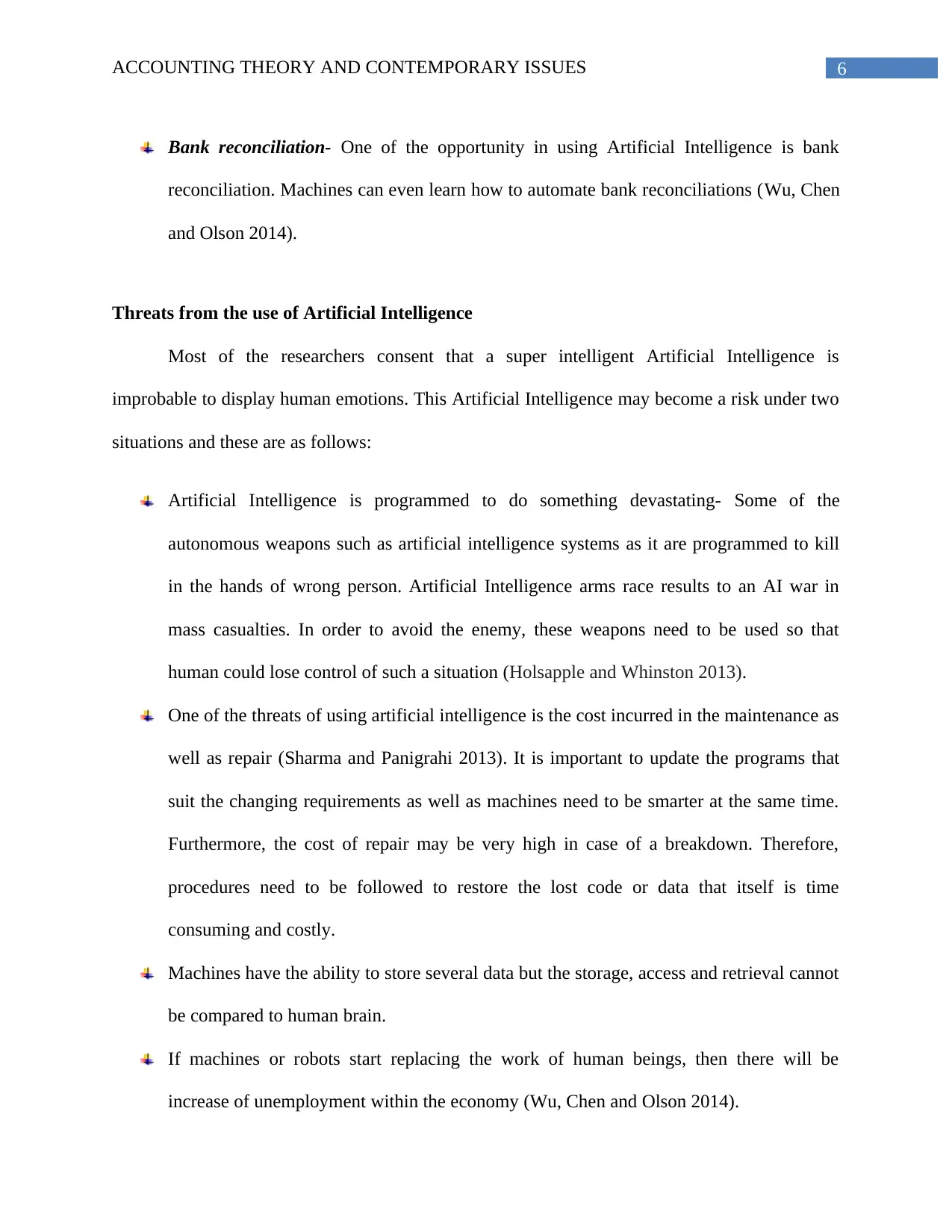
6ACCOUNTING THEORY AND CONTEMPORARY ISSUES
Bank reconciliation- One of the opportunity in using Artificial Intelligence is bank
reconciliation. Machines can even learn how to automate bank reconciliations (Wu, Chen
and Olson 2014).
Threats from the use of Artificial Intelligence
Most of the researchers consent that a super intelligent Artificial Intelligence is
improbable to display human emotions. This Artificial Intelligence may become a risk under two
situations and these are as follows:
Artificial Intelligence is programmed to do something devastating- Some of the
autonomous weapons such as artificial intelligence systems as it are programmed to kill
in the hands of wrong person. Artificial Intelligence arms race results to an AI war in
mass casualties. In order to avoid the enemy, these weapons need to be used so that
human could lose control of such a situation (Holsapple and Whinston 2013).
One of the threats of using artificial intelligence is the cost incurred in the maintenance as
well as repair (Sharma and Panigrahi 2013). It is important to update the programs that
suit the changing requirements as well as machines need to be smarter at the same time.
Furthermore, the cost of repair may be very high in case of a breakdown. Therefore,
procedures need to be followed to restore the lost code or data that itself is time
consuming and costly.
Machines have the ability to store several data but the storage, access and retrieval cannot
be compared to human brain.
If machines or robots start replacing the work of human beings, then there will be
increase of unemployment within the economy (Wu, Chen and Olson 2014).
Bank reconciliation- One of the opportunity in using Artificial Intelligence is bank
reconciliation. Machines can even learn how to automate bank reconciliations (Wu, Chen
and Olson 2014).
Threats from the use of Artificial Intelligence
Most of the researchers consent that a super intelligent Artificial Intelligence is
improbable to display human emotions. This Artificial Intelligence may become a risk under two
situations and these are as follows:
Artificial Intelligence is programmed to do something devastating- Some of the
autonomous weapons such as artificial intelligence systems as it are programmed to kill
in the hands of wrong person. Artificial Intelligence arms race results to an AI war in
mass casualties. In order to avoid the enemy, these weapons need to be used so that
human could lose control of such a situation (Holsapple and Whinston 2013).
One of the threats of using artificial intelligence is the cost incurred in the maintenance as
well as repair (Sharma and Panigrahi 2013). It is important to update the programs that
suit the changing requirements as well as machines need to be smarter at the same time.
Furthermore, the cost of repair may be very high in case of a breakdown. Therefore,
procedures need to be followed to restore the lost code or data that itself is time
consuming and costly.
Machines have the ability to store several data but the storage, access and retrieval cannot
be compared to human brain.
If machines or robots start replacing the work of human beings, then there will be
increase of unemployment within the economy (Wu, Chen and Olson 2014).
⊘ This is a preview!⊘
Do you want full access?
Subscribe today to unlock all pages.

Trusted by 1+ million students worldwide
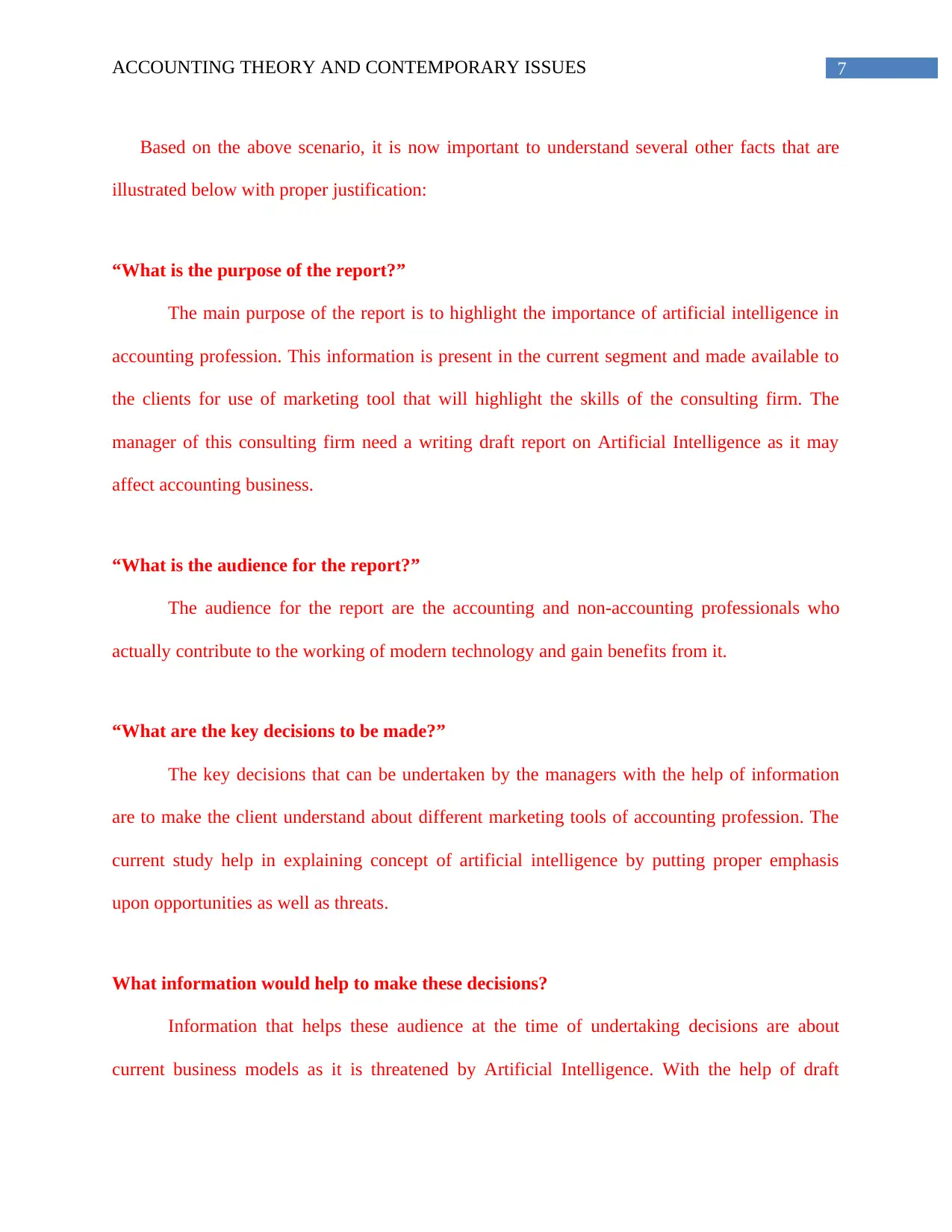
7ACCOUNTING THEORY AND CONTEMPORARY ISSUES
Based on the above scenario, it is now important to understand several other facts that are
illustrated below with proper justification:
“What is the purpose of the report?”
The main purpose of the report is to highlight the importance of artificial intelligence in
accounting profession. This information is present in the current segment and made available to
the clients for use of marketing tool that will highlight the skills of the consulting firm. The
manager of this consulting firm need a writing draft report on Artificial Intelligence as it may
affect accounting business.
“What is the audience for the report?”
The audience for the report are the accounting and non-accounting professionals who
actually contribute to the working of modern technology and gain benefits from it.
“What are the key decisions to be made?”
The key decisions that can be undertaken by the managers with the help of information
are to make the client understand about different marketing tools of accounting profession. The
current study help in explaining concept of artificial intelligence by putting proper emphasis
upon opportunities as well as threats.
What information would help to make these decisions?
Information that helps these audience at the time of undertaking decisions are about
current business models as it is threatened by Artificial Intelligence. With the help of draft
Based on the above scenario, it is now important to understand several other facts that are
illustrated below with proper justification:
“What is the purpose of the report?”
The main purpose of the report is to highlight the importance of artificial intelligence in
accounting profession. This information is present in the current segment and made available to
the clients for use of marketing tool that will highlight the skills of the consulting firm. The
manager of this consulting firm need a writing draft report on Artificial Intelligence as it may
affect accounting business.
“What is the audience for the report?”
The audience for the report are the accounting and non-accounting professionals who
actually contribute to the working of modern technology and gain benefits from it.
“What are the key decisions to be made?”
The key decisions that can be undertaken by the managers with the help of information
are to make the client understand about different marketing tools of accounting profession. The
current study help in explaining concept of artificial intelligence by putting proper emphasis
upon opportunities as well as threats.
What information would help to make these decisions?
Information that helps these audience at the time of undertaking decisions are about
current business models as it is threatened by Artificial Intelligence. With the help of draft
Paraphrase This Document
Need a fresh take? Get an instant paraphrase of this document with our AI Paraphraser
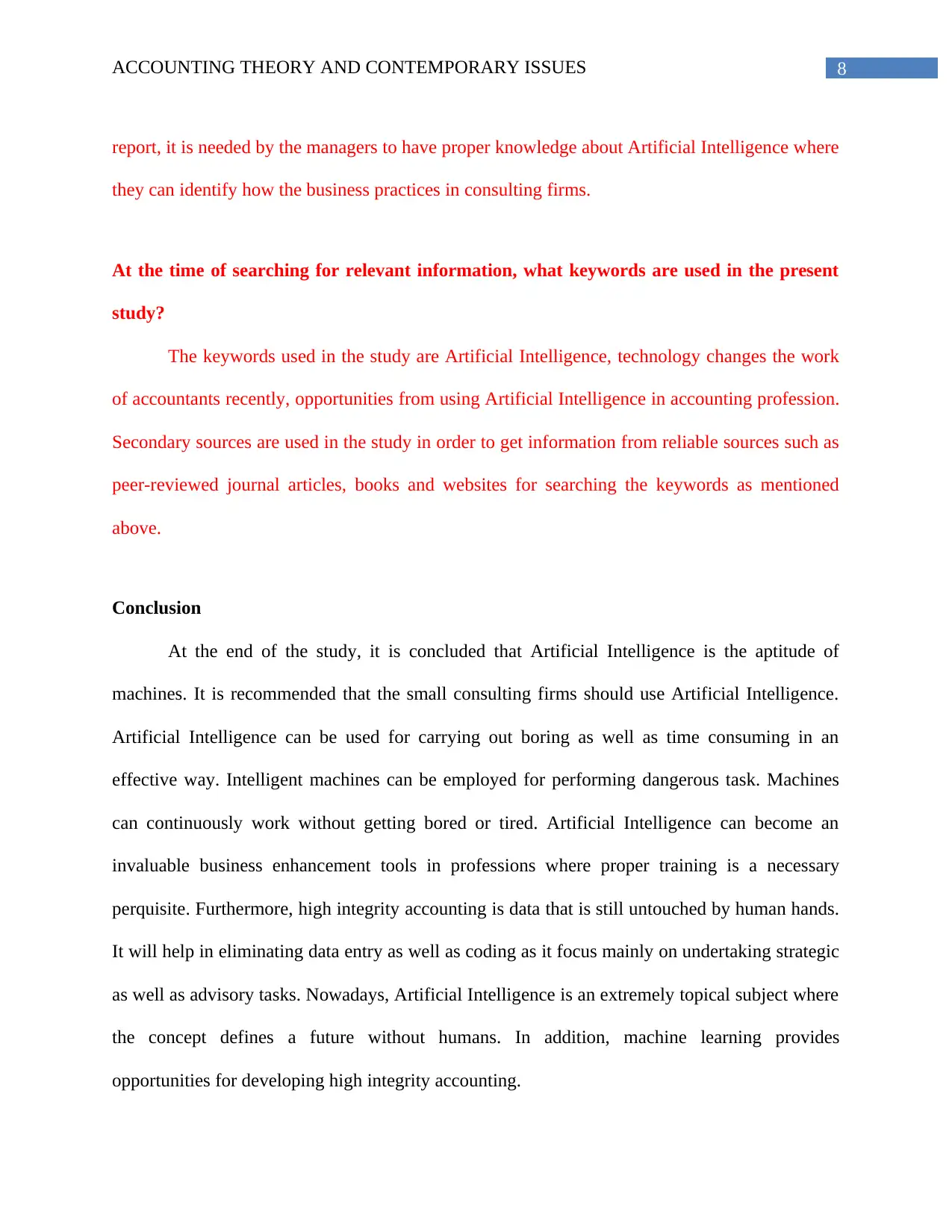
8ACCOUNTING THEORY AND CONTEMPORARY ISSUES
report, it is needed by the managers to have proper knowledge about Artificial Intelligence where
they can identify how the business practices in consulting firms.
At the time of searching for relevant information, what keywords are used in the present
study?
The keywords used in the study are Artificial Intelligence, technology changes the work
of accountants recently, opportunities from using Artificial Intelligence in accounting profession.
Secondary sources are used in the study in order to get information from reliable sources such as
peer-reviewed journal articles, books and websites for searching the keywords as mentioned
above.
Conclusion
At the end of the study, it is concluded that Artificial Intelligence is the aptitude of
machines. It is recommended that the small consulting firms should use Artificial Intelligence.
Artificial Intelligence can be used for carrying out boring as well as time consuming in an
effective way. Intelligent machines can be employed for performing dangerous task. Machines
can continuously work without getting bored or tired. Artificial Intelligence can become an
invaluable business enhancement tools in professions where proper training is a necessary
perquisite. Furthermore, high integrity accounting is data that is still untouched by human hands.
It will help in eliminating data entry as well as coding as it focus mainly on undertaking strategic
as well as advisory tasks. Nowadays, Artificial Intelligence is an extremely topical subject where
the concept defines a future without humans. In addition, machine learning provides
opportunities for developing high integrity accounting.
report, it is needed by the managers to have proper knowledge about Artificial Intelligence where
they can identify how the business practices in consulting firms.
At the time of searching for relevant information, what keywords are used in the present
study?
The keywords used in the study are Artificial Intelligence, technology changes the work
of accountants recently, opportunities from using Artificial Intelligence in accounting profession.
Secondary sources are used in the study in order to get information from reliable sources such as
peer-reviewed journal articles, books and websites for searching the keywords as mentioned
above.
Conclusion
At the end of the study, it is concluded that Artificial Intelligence is the aptitude of
machines. It is recommended that the small consulting firms should use Artificial Intelligence.
Artificial Intelligence can be used for carrying out boring as well as time consuming in an
effective way. Intelligent machines can be employed for performing dangerous task. Machines
can continuously work without getting bored or tired. Artificial Intelligence can become an
invaluable business enhancement tools in professions where proper training is a necessary
perquisite. Furthermore, high integrity accounting is data that is still untouched by human hands.
It will help in eliminating data entry as well as coding as it focus mainly on undertaking strategic
as well as advisory tasks. Nowadays, Artificial Intelligence is an extremely topical subject where
the concept defines a future without humans. In addition, machine learning provides
opportunities for developing high integrity accounting.
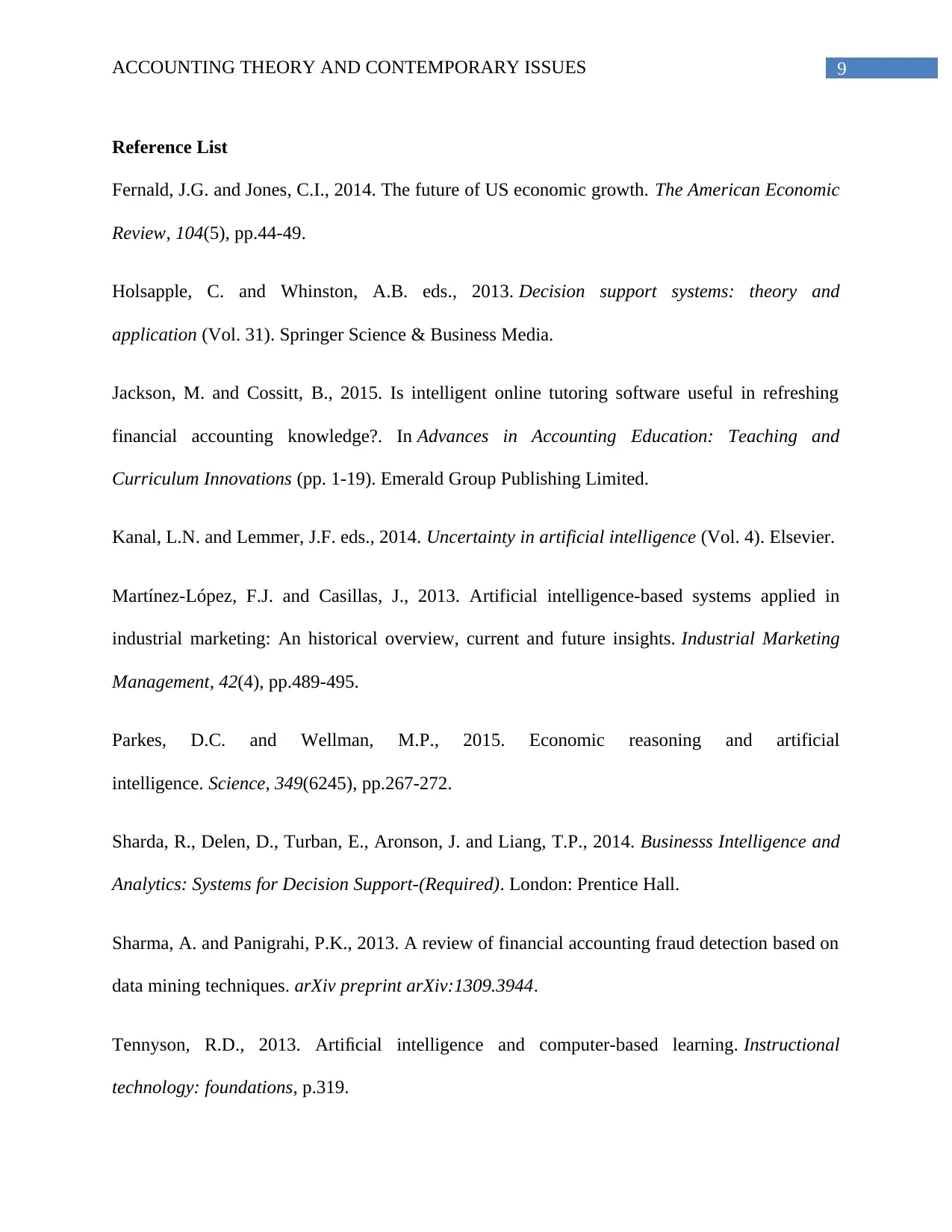
9ACCOUNTING THEORY AND CONTEMPORARY ISSUES
Reference List
Fernald, J.G. and Jones, C.I., 2014. The future of US economic growth. The American Economic
Review, 104(5), pp.44-49.
Holsapple, C. and Whinston, A.B. eds., 2013. Decision support systems: theory and
application (Vol. 31). Springer Science & Business Media.
Jackson, M. and Cossitt, B., 2015. Is intelligent online tutoring software useful in refreshing
financial accounting knowledge?. In Advances in Accounting Education: Teaching and
Curriculum Innovations (pp. 1-19). Emerald Group Publishing Limited.
Kanal, L.N. and Lemmer, J.F. eds., 2014. Uncertainty in artificial intelligence (Vol. 4). Elsevier.
Martínez-López, F.J. and Casillas, J., 2013. Artificial intelligence-based systems applied in
industrial marketing: An historical overview, current and future insights. Industrial Marketing
Management, 42(4), pp.489-495.
Parkes, D.C. and Wellman, M.P., 2015. Economic reasoning and artificial
intelligence. Science, 349(6245), pp.267-272.
Sharda, R., Delen, D., Turban, E., Aronson, J. and Liang, T.P., 2014. Businesss Intelligence and
Analytics: Systems for Decision Support-(Required). London: Prentice Hall.
Sharma, A. and Panigrahi, P.K., 2013. A review of financial accounting fraud detection based on
data mining techniques. arXiv preprint arXiv:1309.3944.
Tennyson, R.D., 2013. Artificial intelligence and computer-based learning. Instructional
technology: foundations, p.319.
Reference List
Fernald, J.G. and Jones, C.I., 2014. The future of US economic growth. The American Economic
Review, 104(5), pp.44-49.
Holsapple, C. and Whinston, A.B. eds., 2013. Decision support systems: theory and
application (Vol. 31). Springer Science & Business Media.
Jackson, M. and Cossitt, B., 2015. Is intelligent online tutoring software useful in refreshing
financial accounting knowledge?. In Advances in Accounting Education: Teaching and
Curriculum Innovations (pp. 1-19). Emerald Group Publishing Limited.
Kanal, L.N. and Lemmer, J.F. eds., 2014. Uncertainty in artificial intelligence (Vol. 4). Elsevier.
Martínez-López, F.J. and Casillas, J., 2013. Artificial intelligence-based systems applied in
industrial marketing: An historical overview, current and future insights. Industrial Marketing
Management, 42(4), pp.489-495.
Parkes, D.C. and Wellman, M.P., 2015. Economic reasoning and artificial
intelligence. Science, 349(6245), pp.267-272.
Sharda, R., Delen, D., Turban, E., Aronson, J. and Liang, T.P., 2014. Businesss Intelligence and
Analytics: Systems for Decision Support-(Required). London: Prentice Hall.
Sharma, A. and Panigrahi, P.K., 2013. A review of financial accounting fraud detection based on
data mining techniques. arXiv preprint arXiv:1309.3944.
Tennyson, R.D., 2013. Artificial intelligence and computer-based learning. Instructional
technology: foundations, p.319.
⊘ This is a preview!⊘
Do you want full access?
Subscribe today to unlock all pages.

Trusted by 1+ million students worldwide
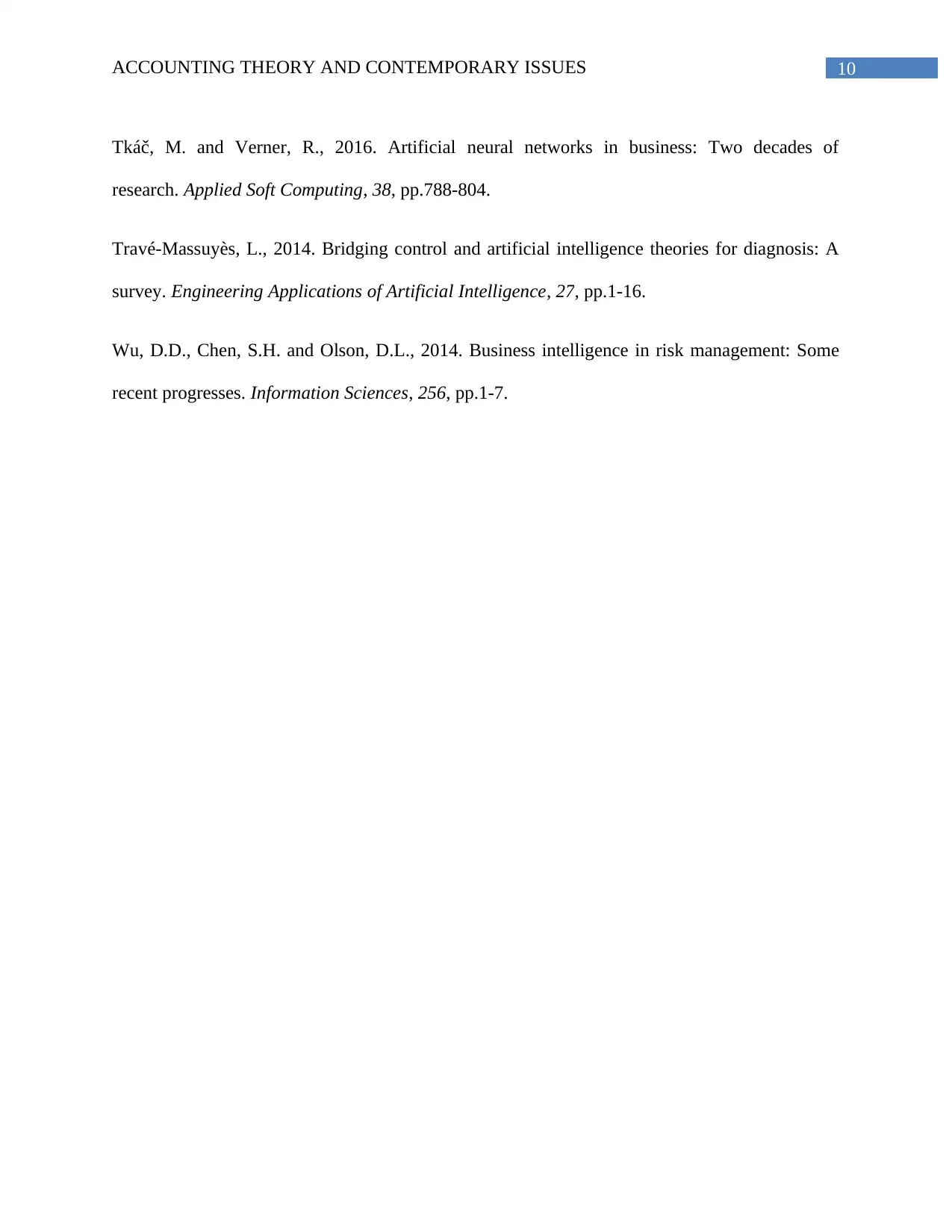
10ACCOUNTING THEORY AND CONTEMPORARY ISSUES
Tkáč, M. and Verner, R., 2016. Artificial neural networks in business: Two decades of
research. Applied Soft Computing, 38, pp.788-804.
Travé-Massuyès, L., 2014. Bridging control and artificial intelligence theories for diagnosis: A
survey. Engineering Applications of Artificial Intelligence, 27, pp.1-16.
Wu, D.D., Chen, S.H. and Olson, D.L., 2014. Business intelligence in risk management: Some
recent progresses. Information Sciences, 256, pp.1-7.
Tkáč, M. and Verner, R., 2016. Artificial neural networks in business: Two decades of
research. Applied Soft Computing, 38, pp.788-804.
Travé-Massuyès, L., 2014. Bridging control and artificial intelligence theories for diagnosis: A
survey. Engineering Applications of Artificial Intelligence, 27, pp.1-16.
Wu, D.D., Chen, S.H. and Olson, D.L., 2014. Business intelligence in risk management: Some
recent progresses. Information Sciences, 256, pp.1-7.
1 out of 10
Related Documents
Your All-in-One AI-Powered Toolkit for Academic Success.
+13062052269
info@desklib.com
Available 24*7 on WhatsApp / Email
![[object Object]](/_next/static/media/star-bottom.7253800d.svg)
Unlock your academic potential
Copyright © 2020–2025 A2Z Services. All Rights Reserved. Developed and managed by ZUCOL.




